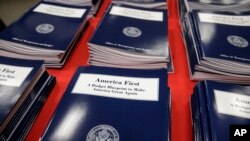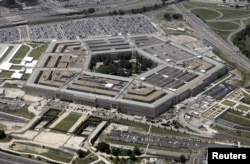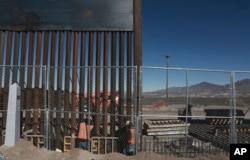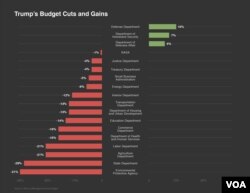AGRICULTURE DEPARTMENT - Down 20.7 percent
The budget would reduce spending National Forest land acquisition, rural water infrastructure and statistical capabilities at the department. It also proposes reduced staff in county USDA offices, an idea that fell flat in Congress when Barack Obama proposed a similar reduction.
The budget would eliminate the International Food for Education and Child Nutrition Program, which uses U.S. agricultural commodities and other financial assistance to support school feeding and child nutrition projects around the world, particularly for girls. The program aims to boost school enrollment, increase academic performance and improve children's health. It is named after former U.S. senators, Democrat George McGovern and Republican Robert Dole, in recognition of their efforts to eradicate childhood hunger.
The program is popular not only with international food aid advocates but with farmers who donate their surplus commodities. Administration budget documents say the program “lacks evidence that it is being effectively implemented to reduce food insecurity.”
The overall numbers: The budget proposes department discretionary spending of $17.9 billion, down $4.7 billion from last year's enacted amount. That doesn't count entitlement programs such as food stamps, which make up the bulk of the Agriculture Department's budget.
Spending that needs Congress' annual approval: $17.9 billion
DEPARTMENT OF COMMERCE - Down 15.7 percent
Eliminates more than $250 million in National Oceanic and Atmospheric Administration grants, including the National Sea Grant College Program that helps coastal communities adapt to climate change, maintain healthy water and fisheries and curb invasive species.
Spending that needs Congress' annual approval: $7.8 billion.
DEFENSE DEPARTMENT - Up about 10 percent
Defense spending rises by $52 billion, with extra money going to accelerate the war against the Islamic State group and address insufficient weapons stocks, personnel gaps, deferred maintenance and cyber vulnerabilities. An additional $2 billion would be used for nuclear weapons.
Base budget of $574 billion is to operate the department, plus $65 billion in war funds, for a total budget of $639 billion.
Spending that needs Congress' annual approval: $639 billion.
DEPARTMENT OF EDUCATION - Down 13.5 percent
The proposed budget would slash department funding by $9.2 billion from this year's $68.2 billion, a major cut unseen in recent years. The administration is proposing to allocate an additional $1.4 billion for school choice programs and to eliminate two programs worth $3.6 billion that provide funding for teacher preparation and after-school programs, among other plans. School choice - charter and private schools programs for families who are not happy with traditional public school options available to them - has been a key priority for Trump and his Education Secretary Betsy DeVos who has said that a “one size fits all” system doesn't work for America's children.
Spending that needs Congress' annual approval: $59 billion
DEPARTMENT OF ENERGY - Down 5.6 percent
Trump's budget would hike spending for the National Nuclear Security Administration, which is responsible for maintaining the nuclear stockpile, by 11 percent, while cutting other energy spending by nearly 18 percent. The budget seeks $120 million to revive the mothballed Yucca Mountain nuclear waste repository, which is hugely unpopular in Nevada and was largely stopped by the efforts of former Democratic senator Harry Reid.
The budget also slashes $700 million from an Energy Department office that promotes energy efficiency and renewable energy and eliminates the Office of Science and the Advanced Research Projects Agency-Energy (ARPA-E), which supports research into new energy technologies.
Spending that needs Congress' annual approval: $28 billion.
ENVIRONMENTAL PROTECTION AGENCY - Down 31.4 percent
Trump's proposal would slash spending for environmental protection by nearly $2.6 billion, or 31 percent, one of the biggest cuts in the president's budget. More than 3,000 EPA workers would lose their jobs, and programs such as Obama's Clean Power Plan - which would tighten regulations on emissions from coal-fired power plants that contribute to global warming - would be eliminated.
The budget also eliminates funding for regional programs to restore the Great Lakes and clean up the Chesapeake Bay, as well as Energy Star, a popular program to promote efficiency in home appliances.
Popular EPA grants for state and local drinking and wastewater projects would be preserved, however, even as research into climate change would be eliminated.
Spending that needs Congress' annual approval: $5.7 billion
HEALTH AND HUMAN SERVICES - Down 16.2 percent
The budget plan would cut $5.8 billion from the nearly $32 billion National Institutes of Health, the nation's premier medical research agency, or roughly 18 percent. NIH's budget hasn't kept pace with inflation over the past decade, making it much harder for scientists around the country to win funding for research projects into potential new treatments or better understanding of disease.
The budget calls for discretionary spending of $65.1 billion, down $12.6 billion from 2017. That doesn't address entitlement programs like Medicare and Medicaid, which make up the vast majority of HHS spending. The budget also calls for spending of $1.1 billion on FDA drug review under the 21st Century CURES Act, and $400 million on efforts to stem waste, fraud and abuse.
Spending that needs Congress' annual approval: $66.6 billion
HOMELAND SECURITY DEPARTMENT - Up 6.8 percent
President Trump's budget asks for a total increase of about $2.8 billion. That includes a request for $2.6 billion to start Trump's much promised border wall, though he has said Mexico will eventually pay for the barrier. Mexico has repeatedly rejected any such suggestion.
The president also wants Congress to approve an extra $1.5 billion for Immigration and Customs Enforcement to spend on finding, jailing and deporting immigrants who are in the country illegally.
Spending that needs Congress' annual approval: $44.1 billion
DEPARTMENT OF HOUSING AND URBAN DEVELOPMENT - Down 13.2 percent
The budget would eliminate the Community Development Block Grant program, a $3 billion effort that funds local improvement efforts. Mayors, city officials and housing advocates say the grants provide critical money to communities for infrastructure improvements for seniors, open space projects in poor neighborhoods, and social service programs such as Boys and Girls Clubs. The proposed budget says the block grant program “is not well-targeted to the poorest populations and has not demonstrated results.” While killing money for the grants program, the Trump budget would increase, by $20 million, money to promote lead-safe homes for low-income people.
Spending that needs Congress' annual approval: $40.7 billion
INTERIOR DEPARTMENT - Down 11.7 percent
The budget calls for cutting $120 million in spending on land purchases with a focus on using available funds to maintain existing parks and wildlife refuges.
Spending that needs Congress' annual approval: $11.6 billion.
NATIONAL AERONAUTICS AND SPACE ADMINISTRATION - Down 0.8 percent
Eliminates Obama's asteroid redirect mission that would have used a robotic probe to grab a chunk of an asteroid, bring it close to the moon and then send astronauts to explore it. Also cuts the $115 million NASA education program and four Earth science missions that look at climate change, solar storms and ocean health.
Spending that needs Congress' annual approval: $19.1 billion.
DEPARTMENT OF LABOR - Down 20.7 percent
Though Trump has said he'd advocate for U.S. workers, his budget includes cuts to several programs. It would eliminate the $434 million Senior Community Service Employment Program, which, according to the Labor Department website, has helped more than 1 million Americans over age 55 find work.
Spending that needs Congress' annual approval: $9.6 billion
STATE DEPARTMENT - Down 28.7 percent
Reduces funding to the United Nations and its affiliated agencies, and caps American contributions to U.N. peacekeeping missions at 25 percent of the total costs.
Cuts funding to the World Bank and multilateral development banks by about $650 million over three years, compared to commitments made by Obama administration.
Includes $2.2 billion for new embassy construction and maintenance, and retains $3.1 billion in Israel aid. Eliminates the U.N. Green Climate Fund, which helps developing nations reduce greenhouse gas emissions, and ends funding for other U.N. climate change programs. Also eliminates the Emergency Refugee and Migration Assistance account for humanitarian crises and the Complex Crises Fund, which pays for conflict resolution efforts.
Shifts some foreign military assistance from grants to loans.
Calls for State Department and USAID to reorganize and consolidate.
The $37.6 billion budget proposal is split between $25.6 billion in “base funding” for regular programs and $12 billion for “overseas contingency operations,” a wartime account that covers operations in places like Iraq, Afghanistan and Syria. USAID funding is included in the base funding.
Spending that needs Congress' annual approval: $37.6 billion.
DEPARTMENT OF TRANSPORTATION - Down 12.7 percent
Calls for taking responsibility for air traffic control operations away from the Federal Aviation Administration and giving it to a “non-governmental organization,” most likely a nonprofit corporation. Airlines, which would have seats on the corporation's board, have made air traffic control privatization a top priority. They say the FAA is taking too long to modernize the system. FAA Administrator Michael Huerta says the modernization program has made “tremendous progress.”
Spending that needs Congress' annual approval: $16.2 billion
TREASURY DEPARTMENT - Down 4.4 percent
After years of budget cuts, the IRS budget would be reduced again, by $239 million from this year. The IRS budget is down about $1 billion from its height in 2010. Since then, the agency has lost more than 17,000 employees. As a result, the chances of Americans getting audited have rarely been so low.
Treasury Secretary Steven Mnuchin told senators at his confirmation hearing that he would make the case to President Trump that increasing funding for the IRS would increase tax revenue for the government.
“He'll get that completely. That's a very quick conversation with Donald Trump,” Mnuchin said at the time.
Spending that needs Congress' annual approval: $11.2 billion.
VETERANS AFFAIRS - Up 5.9 percent
The budget proposes an increase of more than $4 billion to strengthen medical care at more than 1,200 VA facilities serving more than 9 million enrolled veterans as the Department of Veterans Affairs broadens its health network to include outside community providers. The plan also calls for $3.5 billion in mandatory budget authority to pay for an extension of the Veterans Choice program, which allows eligible veterans to seek care from private doctors outside the VA network. That troubled program, which the VA says it wants to revamp, is to expire in August.
Spending that needs Congress' annual approval: $78.9 billion.












